The Car Meta in Rocket League - A Guide to Picking the Right Car for You
Don't know what car to use in Rocket League? Read this guide to find the right car for you!
Don't know what car to use in Rocket League? Read this guide to find the right car for you!
As in-depth and complex competitive Rocket League can be, at the end of the day the only thing you truly have control over is your rocket-powered battle-car. When posed with the question of which car is the best, a very common (and for the most part correct) answer is that it is based off preference and you should drive whatever you are comfortable with. With 10 cars in the base game, plus an extra 37 cars in the form of DLCs and crate content (with more on the way), it can be quite a daunting choice for players looking to main a car, whether it be a newcomer or an experienced player looking for something fresh. As in any game, pro play heavily influences the meta. Rocket League is no exception with many basing their car choice off what the professionals use.
What the Pros Use
Below is a table compiling the main battle-car of each player competing at the RLCS World Championships in London.

As seen above, a clear favourite for pros is the Octane, with only 10% opting for something outside of the Octane. You may be asking why this is the case? To gain a better a understanding, a knowledge of the hitbox classes in Rocket League is essential.
The Different Hitbox Classes
In Rocket League, there are five "classes" of battle-car. These classes consist of Octane, Dominus, Breakout, Hybrid and Plank, and each one has a set of defined characteristics. Below is a table featuring the five hitbox presets and the battle-cars that fall under each.
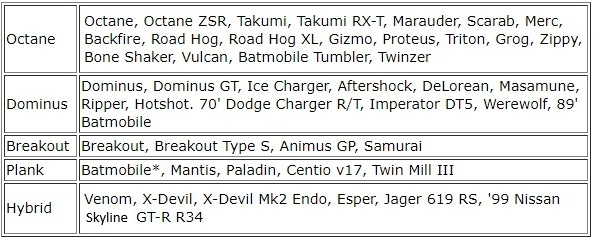
With that in mind, let's take a closer look at each preset.
Octane Hitbox - Tried and Tested
Despite the name, the Octane hitbox class is home to a wide variety of vehicles in Rocket League - a full roster of 19 in fact.
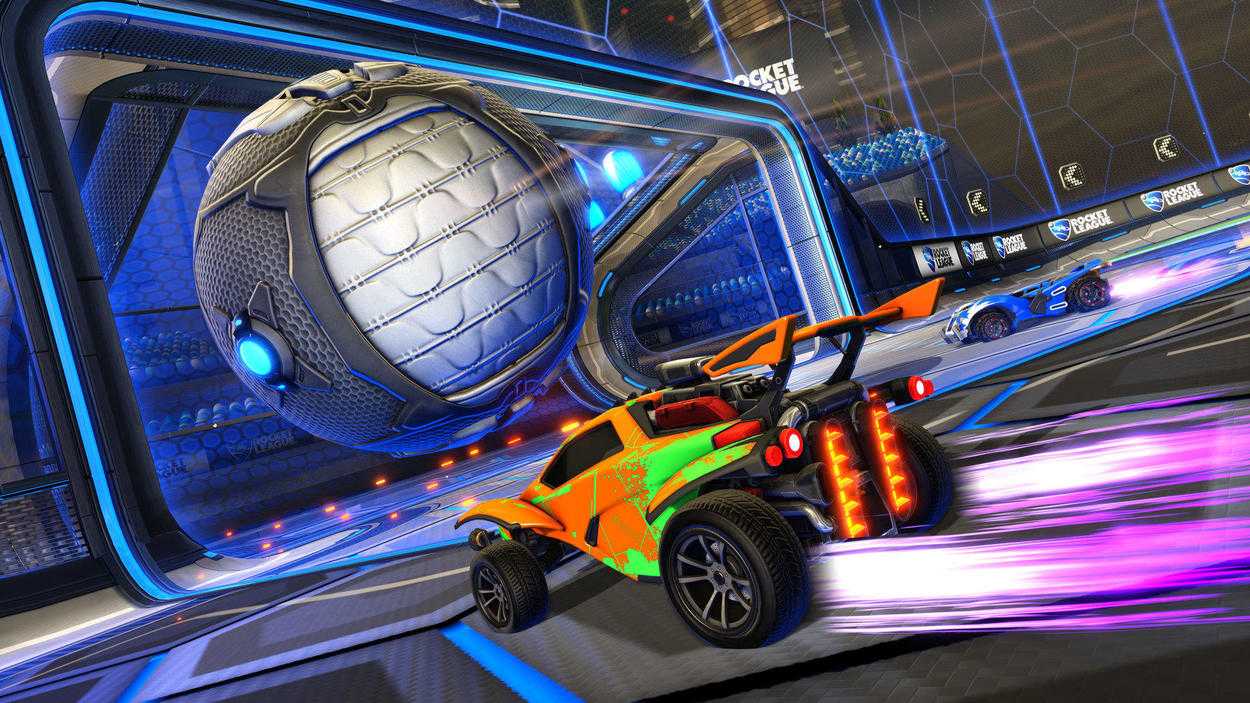
Credit - Psyonix
The octane is considered by many to be one of the most balanced and well-rounded cars in the game. Even though 18 vehicles share the same hitbox as the Octane, nothing quite compares to the overall feel and familiarity of the Octane. This is due to a number of factors, with the main being the fact that the "Octane" preset is literally named and modelled after this specific battle-car and the Octane most closely fits its dimensions. Other factors that affect the overall feel of a car are hitbox elevations and pivot points.

Credit - Liquipedia
Compared to other classes, the Octane preset is considered to be one of the best "all-purpose" hitboxes, being relatively middle of the pack statistics wise. Out of all the hitbox presets however, the Octane class is the tallest at 36.16 units. This height advantage gives players additional room for control in ground-based play, most notably in bounce dribbling and 50/50s, as brilliantly shown by NRG Esports' Garrett "GarrettG" Gordon in the North American regional playoffs against Evil Geniuses.
A major downfall as a result of the Octane's height however is giving opponents a bigger (taller and higher off the ground) target to aim for when going for demolitions. A common tactic for players trying to avoid getting demolished is to jump over the opponent looking to demolish, as the tactic has grown in popularity and usage, players trying to demolish have evolved their methods with many pre-jumping a demolition attempt in anticipation of a defending player doing likewise. Due to the Octane's height of 36.16 units, along with a considerable height offset off the ground, players looking for demolitions can still take out a grounded octane even after pre-jumping, a downfall that shorter presets do not have.
Despite the Octane's height being a weakness in terms of getting demolished; its height, along with its offset off the ground (or in this case the wall), makes it easier for its users in wall-based plays. As opposed to perhaps having to time a jump off the wall to reach a ball in flatter presets, the taller hitbox of the Octane gives players a better chance to make contact while still staying on the wall, a major plus for beginner players who perhaps have not mastered the mechanics of wall-based play and aerials.
Along with the Octane's height providing an advantage for beginners on the walls, the height of the Octane hitbox is also beginner friendly due to its softer touches, due to the "padding" on the hitbox. Despite its popularity, the Octane battle-car has a seemingly poor visual representation of its hitbox in certain parts, especially the upper front edge of the hitbox. However one of the best elements of the Octane is the choice players have in where/how you can hit the ball, despite having noticeably softer touches than most other cars, you can still absolutely smash a ball if it is hit with a bottom edge or corner of the Octane, where the model meets the hitbox.
Another reason many chose to main the Octane is simply down to familiarity with the vehicle, a sentiment especially applicable to pros. Ever since Rocket League's release in 2015, the Octane has been the very first vehicle you unlock, with many pros choosing to stick with it over the years despite countless new releases. As seen earlier, another option RLCS pros opt for is the Dominus (roughly 6% of players heading into to LAN), an ever-present and effective weapon in competitive Rocket League.
Dominus Hitbox - A Freestyler's Favourite
Similar to the Octane hitbox, the Dominus class is home to more than just its namesake, a grand total of 12 battle-cars.
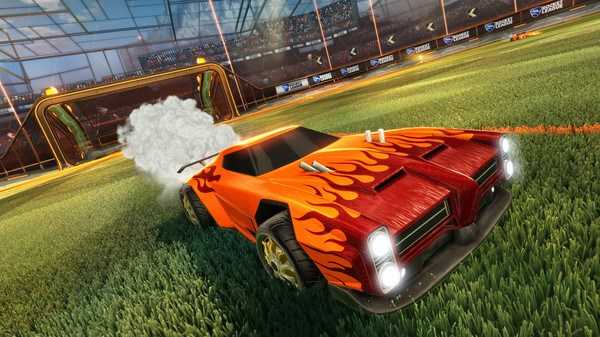
Credit - Psyonix
In reality, the hitbox classes are not wildly varying. However, each one has its own subtle nuances that players pick up over time. A prominent example of this notion is a comparison between the Octane and Dominus hitboxes, and the parallels and differences in playstyle stemming from their unique characteristics. Seen below is the hitbox stats and turning figures for the Dominus hitbox preset.

Credit - Liquipedia
The Dominus hitbox, in particular the Dominus itself, is known for its precision and aerial maneuverability. These qualities can be attributed to the visual correlation between the Dominus and its hitbox, in its distinct corners and relative flatness. As for raw statistics, the Dominus preset is seemingly middle of the pack, coming in at third in terms of length and height. However, this class has the greatest surface area at 34529 units. The surface area of the Dominus is only fractionally greater than that of the Octane, the value of this quality for the Dominus however comes in how it is distributed, mostly spread across its length and width as opposed to height creating a "paddle" like frame.
The paddle like frame of the Dominus gives it a number of advantages as opposed to taller hitboxes such as the octane. As previously mentioned the height of the Octane makes it an easy target for demolitions, as opposed to flatter presets, such as the Dominus. The shortness of the Dominus also allows for players to get under the ball with more ease to start dribbling plays or quickly whip out a flick to send the ball skyward. The shortness of the Dominus, along with its length at 127.93 units, makes its hitbox particularly strong at flicks, similar to the Breakout and Plank presets.
The distribution of the Dominus' surface area allows for the aforementioned precision of the this preset, prominently featured in Rocket League "freestyling" - with many freestylers opting for the Dominus.
A main disadvantage of the Dominus hitbox preset is its shortcomings in terms of 50/50s due its lacking height in comparison to the Octane. The height of the Dominus at 31.30 units makes it significantly harder for players to win 50/50's, especially against Octanes. This is due to Octanes having a larger front surface area, meaning Octane users have more hitbox to work with when trying to block or power through other smaller presets. This is a struggle for most hitboxes outside of the Octane - hitboxes such as the Breakout.
Breakout Hitbox - An Icon of the Past
Dissimilar to the Octane and Dominus hitbox classes, the Breakout hitbox stays mostly true to its namesake, home to the Breakout, Breakout Type-S, Animus GP and the Samurai.
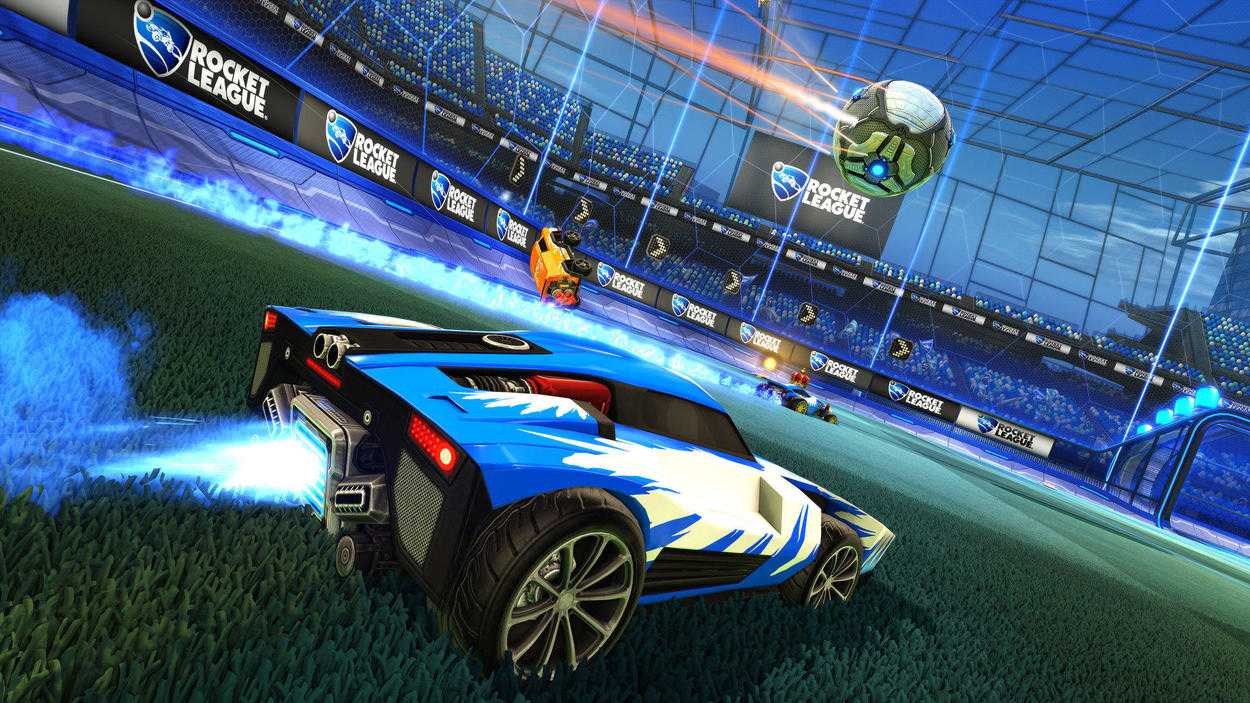
Credit - Psyonix
The Breakout Hitbox is a very unique one with some very interesting characteristics. In many ways the Breakout hitbox is just a longer, narrower Dominus.

Credit - Liquipedia
A major benefit from flatter presets such as Breakout, along with Dominus and Plank, is their ability to produce absurd flicks, a product of their length and lack of height. The breakout is perhaps the most pertinent example of this notion as it is the longest hitbox at 131.49 units (2.67 units more than its closest competitor, the Plank preset). Due to its similarities with the Dominus, the Breakout is also a very viable vehicle in the field of freestyling. Along with that, the Breakout (and to a certain extent the Type-S) have strong correlations between their hitboxes and visual representations; a quality perhaps not shared with the Animus GP and Samurai.
The Breakout's aerial capability and overall precision has led it to be a favourite for some of the game's most infamous rocketeers, most notably the freestyling phenom Joni "JHZER" Humaloja.
Despite its qualities, just like the Dominus and Plank presets the Breakout hitbox class is lacking when it comes to 50/50's. It struggles from the same downfalls of the Dominus, with the Breakout hitbox being one unit shorter than the height of the Dominus.
In relation to the eSports scene, the Breakout is a notable absence with 0 of the 30 players attending the World Championships this season using a variant of the Breakout hitbox. Disregarding LAN players, the Breakout also failed to feature prominently from any player in this season of the RLCS. This lack of Breakout representation in the competitive scene has not always been the case however, with former pros such as Season 1 legend Gambit maining the vehicle in IBP Cosmic's championship winning season and the seasoned veteran Espeon's extensive use of the Breakout throughout his career. The Breakout has also made sporadic appearances at the hands of Rogue's Jacob "Jacob" McDowell; along with G2's Cameron "Kronovi" Bills maining the vehicle in the majority of season 2 of the RLCS.
Plank Hitbox - Name Says It All
Home to five battle-cars, the Plank hitbox class is known for its well... "plankness". Despite the name, this preset was not modelled after a sturdy plane of wood but rather the ever-popular Batmobile.
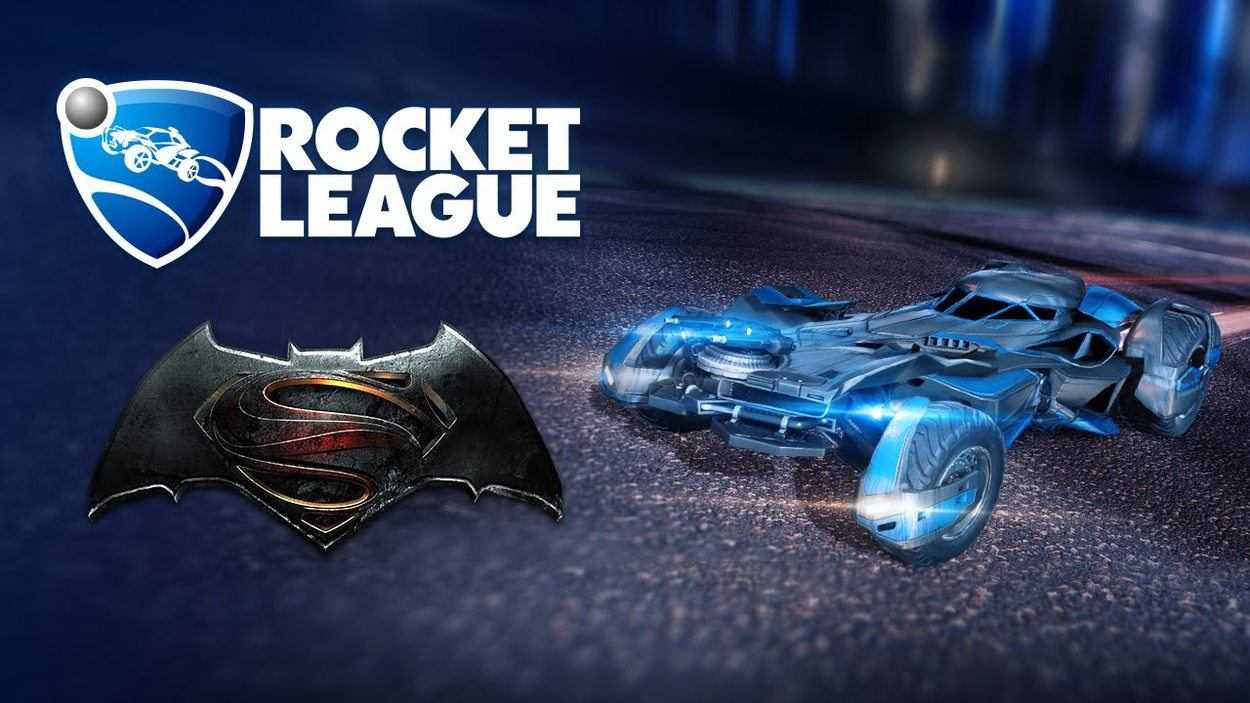
Credit - Psyonix
Since its release in March 2016, the Batmobile has been a ubiquitous battle-car in Rocket League arenas. The Plank hitbox's name stems from is hitbox statistics, being the widest, flattest and second longest preset.

Credit - Liquipedia
As seen above, the Plank hitbox class is the shortest at 29.39 units. Similar to the Dominus and Breakout hitboxes, this lack of height allows for battle-cars in the Plank preset to get under the ball with ease. When this height is paired with the Plank hitbox's length (128.82 units) and width (84.67 units), the plank preset, and in particular the Batmobile, can produce absolute boomers from flicks. One of the most iconic Batmobile flick goals scored throughout Rocket League's history is the one scored below by compLexity gaming's Joonas "Mognus" Salo.
With a lack of height, it would seem that weakness in 50/50's follows for hitbox presets. For the most this sentiment applies to the Plank hitbox preset and by extension of the Batmobile; however one main advantage the Batmobile has over other cars in terms in 50/50's is its width. With correct use of air rolls and expert manipulation of your car's orientation, the Batmobile can be a robust vehicle in challenges. Despite it being relatively easily to win a 50/50 over or under a Batmobile, the Batmobile's width makes it difficult for opponents to muscle the ball around your car. So in challenges always make sure the nose of your car is directly hitting the centre of the ball and keep rotating to keep as much of the car's width on the ball as possible in challenges when using a Batmobile or other Plank vehicle.
The Batmobile has been known for its ability to make the seemingly impossible possible over its lifespan. This quality is not necessarily a byproduct of hitbox statistics but rather just seemingly a magical power of the Batmobile that does not translate to other vehicles in the Plank preset (See Kuxir97's Reddit post concerning hitbox standardisation for the Batmobile). It is important to note that the Batmobile technically does not fall under the Plank class due to slight discrepancies in turning radii, elevation and pivot points, however these differences are negligible to inexperienced Plank/Batmobile users. The Batmobile's freakish abilities have been shown best by one man throughout his competitive career time and time again - FlipSid3 Tactics' Francesco "Kuxir97" Cinquemani.
Unlike the Breakout, the Batmobile has stayed relevant in Rocket League's competitive scene, with some of the world's best choosing to main the car such as Renault Vitality's Victor "Fairy Peak" Locquet and the aforementioned Kuxir97. A less popular option amongst the pros, and perhaps even the entire Rocket League player base, is the "Hybrid" hitbox preset.
Hybrid Hitbox - Best (or Worst) of Both Worlds
Eight cars fall under the Hybrid preset, a mix of cars lacking any stand-out features. The Hybrid hitbox class was created to standardise these vehicles into one class.

Credit - Psyonix
Cars that fall in the Hybrid preset are seen throughout the community as "lacking" in many aspects. More than any other class, this hitbox provides the least competitive edge. It is weak in 50/50s and bounce dribbling due to its height in comparison to the Octane. This can attributed to a hitbox height of 34.16 units (two units less than the Octane) and a width of 82.19 units (2.01 units less than the Octane).

Credit - Liquipedia
Similar to the Octane class, cars in the Hybrid preset have a relatively difficult time at avoiding jumping demolitions. In saying this however the Hybrid class has the edge in this department being two units shorter than the Octane along with less of an offset from the ground. This lack of height in comparison to the Octane also makes it easier to get under the ball for flicks, despite this however there are simply much better presets for flicking, such as the Dominus, Breakout or Plank. Perhaps the worst aspect of this preset however is that most battle-cars that fall into this class have poor model - hitbox visual representations, making difficult for players to have true control over their touches. In all fairness to this preset, it is definitely a "hybrid" of other classes and does have its occasional shining moments. Cars in this class such as the '99 Nissan Skyline GT-R R34 do actually have relatively strong visual representations, helping its cause in aerial play.
For inexperienced players, this preset may act as a good middle-ground hitbox to test your skills and find what you are good at. In terms of professional play, the Hybrid class is by far the least popular, with perhaps some pros opting to trial these cars at their release. An example of this is Team Dignitas' very own Pierre "Turbopolsa" Silfver using the Skyline throughout last season's regional finals. Despite all there is to be said about the cars in Rocket League, picking one to stick with is a daunting task.
What Car Is for You?
Still don't know what car is for you? That is perfectly fine! Most players struggle with this identity crisis at some point. Even though throughout this guide each hitbox preset in the game has been presented with why you should or should not main them, you don't have to stick with one for the rest of your life. A great aspect of Rocket League is that you are in total control. This means you can use whatever car whenever and however you want, but let's be real, you are here to find your supersonic acrobatic rocket powered future, a car 'til death do you part.
Each car has its pros and cons and each one is "best" for a certain playstyle. If you want consistency, control, and to be just like the pros - then go with the Octane. There honestly isn't a car that better meets that criteria. If you fancy yourself as an aerial maestro with a will to send the ball flying towards the net off a nasty flick, then a flatter preset like Dominus, Breakout, Plank or even, to a certain extent, Hybrid is recommended. And if you like to roleplay as the ball itself, then go for the Scarab. The choice is yours.
Like our content? Support us by getting our merchandise in our shop